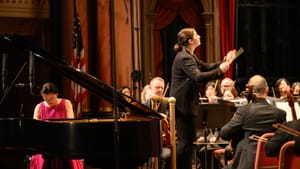Stay in the Loop
BSR publishes on a weekly schedule, with an email newsletter every Wednesday and Thursday morning. There’s no paywall, and subscribing is always free.
Welcoming new music director Michelle Di Russo
Delaware Symphony Orchestra presents Virtuosity Unleashed

In November 2024, Michelle Di Russo led the Delaware Symphony Orchestra (DSO) as a guest conductor, appearing again in the spring of 2025 as part of the orchestra’s multi-year leadership search. Now she returns, this time taking the podium as the DSO’s new music director, just the sixth in the ensemble’s century-plus history.
Di Russo inaugurated her tenure with Virtuosity Unleashed, a thrilling concert that lived up to the title. As always, the DSO opened this first concert of the season with the national anthem, after which the new music director introduced herself and spoke about each of the evening’s three works.
A musical visit to Mexico City
The orchestra then launched into Antrópolis (2018) by Grammy-winning Mexican composer Gabriella Ortiz. Di Russo (a native of Argentina) chose this work to honor her Latin American roots. The work is a musical visit to the nightlife and night spots (called antros) of Mexico City, the composer’s hometown. Pulsing and syncopated, it’s filled with mesmerizing dance-like rhythms and exciting riffs for percussion, winds, and sliding brass. Antrópolis opens with a very difficult (recurring) timpani solo with thrilling glissandos (how is that done?), and at the 10-minute work’s fiery conclusion, principal timpanist Bill Wozniak received roars from the delighted audience.
Channeling Rachmaninoff
And those weren’t the only roars of the evening. The next work on the program was the famous three-movement 1909 Piano Concerto in D minor by Sergei Rachmaninoff. The concerto opens with a well-known melancholy melody for solo piano—an eloquent and deceptively simple setup for the pianistic and orchestral fireworks that follow.
Not all keyboard artists will undertake this difficult concerto, but pianist Fei-Fei played the work as if breathing it—with intelligence, insight, and a fierce virtuosity tempered by lyrical grace. She offered the composer’s famous cadenza (which lore says he himself was loath to play) with consummate and joyful mastery. And she listened closely and physically responded to the DSO musicians with such intense concentration that her solo sections rose organically out of the work’s often-dense texture. Quicksilver changes, never arbitrary, were always a response to the orchestral context, and it often felt as if she were channeling Rachmaninoff himself.
Di Russo and the DSO matched Fei-Fei’s extravagant musicality and exceptional virtuosity. Throughout, the conductor expertly led a supple and responsive orchestra, tightly tuned and sounding often like a single voice, through Rachmaninoff’s changing tempi and moods. At the work’s conclusion, the audience leapt up as one (a genuine standing ovation, not the kind that has now become almost de rigeur), bringing conductor and pianist onstage for multiple bows. And as an encore, Fei-Fei unexpectedly offered a Rachmaninoff prelude of surpassing beauty.
Tchaikovsky’s ode to joy
After intermission, the orchestra played another Russian work, Tchaikovsky’s Symphony No. 4, which premiered in 1878. Though both this and Rachmaninoff’s concerto are considered classics of Russian romanticism, the earlier Tchaikovsky work is very much different in style: each of its four programmatic movements has a distinct narrative quality.
The symphony opens with an ominous, insistent unison brass fanfare that the composer felt portrayed a fateful life force, but it is studded throughout with increasingly hopeful sections. The second, more melancholy movement begins with a lyrical oboe solo, echoed by the low strings, a motif that is filigreed throughout the movement.
The third movement is a total change, a scherzo with the strings playing almost continuously in the insistent and whimsical pizzicato ostinato dictated by the composer, something that demands the clockwork precision that the DSO string sections delivered. And the final movement is Tchaikovsky’s own ode to joy that begins with an orchestral flourish and crashing cymbals as he reprises some of the first-movement motif and builds to a majestic whirlwind of musical energy.
An orchestral treasure
Here, as throughout the evening, Di Russo led the orchestra with assurance and technical skill, rising to every challenge of this magnetic and enveloping program. At a previous concert, she told the audience that this orchestra is a “treasure.” Clearly joyful to be the DSO’s new music director and welcomed by an excited audience, an enthusiastic Di Russo finds herself poised to unleash the promised “bold new season” of this 120-year-old orchestra, a treasure now under her baton and in her hands.
What, When, Where
Virtuosity Unleashed. Gabriella Ortiz, Antrópolis; Sergei Rachmaninoff, Piano Concerto No. 3; and Pyotr Tchaikovsky, Symphony No. 4. Conducted by Michelle Di Russo. Fei-Fei, piano. Delaware Symphony Orchestra. October 10, 2025, at the Grand Opera House’s Copeland Hall, 818 N Market Street, Wilmington. (302) 656-7442 or delawaresymphony.org.
Accessibility
The Grand’s Copeland Hall is wheelchair accessible, and assistive listening devices are available.
Sign up for our newsletter
All of the week's new articles, all in one place. Sign up for the free weekly BSR newsletters, and don't miss a conversation.

 Gail Obenreder
Gail Obenreder